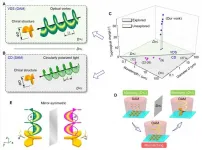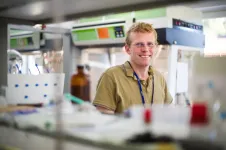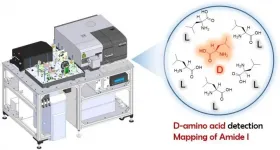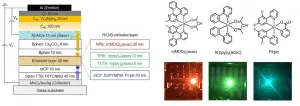In equilibrium
Lithium-magnesium alkyl-alkoxy intermediates in Br-Mg exchange
2021-03-02
(Press-News.org) Organometallic reagents are essential tools in synthetic chemistry. They work even better and more effectively in combination with alkali alkoxides. The exact nature of this effect has never been well understood. A team based in Switzerland has now performed a detailed study of the mechanism of reaction of aryl bromides with organo-magnesium reagents and lithium alkoxides. As reported in the journal Angewandte Chemie, a complex equilibrium of bimetallic intermediates plays a key role.
Substituted aromatic ring systems are an important class of building block for the synthesis of many products, including pharmaceuticals, agrochemicals, and natural substances. However, the required functional side groups cannot generally be hooked onto the ring systems in a simple way. A widely employed method uses a detour through a halogen/metal exchange. First, a halogen atom, such as bromine, is attached to the desired position on the ring system. With the use of special organometallic reagents--compounds with at least one metal-carbon bond--the Br atom can be exchanged for a metal atom, such as magnesium. The Mg atom can then easily be replaced by the desired substituent.
Interestingly, the use of alkali alkoxides in conjunction with the organometallic reagents causes synergistic effects; that is, increased reactivity and altered reactivity profiles. In this manner, lithium alkoxides (LiOR) activate the organo-magnesium reagent sBu(2)Mg (di-sec-butylmagnesium), allowing for an Mg/Br exchange with bromine-containing aromatics.
A team led by Eva Hevia at the University of Bern (Switzerland) has now taken a closer look at this type of reaction, using various methods to trap and analyze the organometallic intermediates that are formed. "We have found a complex equilibrium between various bimetallic species," says Hevia. "The key components are two different intermediates of the Br/Mg exchange that depend on the substitution pattern of the aromatic substrate."
Detailed NMR spectroscopic studies showed that the heart of the reaction is a novel version of the Schlenk equilibrium between bimetallic intermediates, lithium magnesiates, which have different sets of ligands and different Li:Mg ratios. Surprisingly, the in situ generation of an alkyl-rich lithium magnesiate is revealed as the active species of the Mg/Br exchange.
"Our insights advance our understanding of the modus operandi of these fascinating bimetallic systems," states Hevia, "which could pave new paths toward new exciting synthetic applications."
INFORMATION:
About the Author
Originally from Gijon (Spain), Dr. Eva Hevia is a Professor of Inorganic Chemistry at the University of Bern (Switzerland). Research in her group focuses on polar organometallic chemistry at the crossroads of inorganic, organic, and green chemistry with a special emphasis on mechanistic understanding. She is a Fellow of the European Academy of Sciences and her research has been recognized with several awards; e.g., by the British and Spanish chemical societies (RSC, RSEQ)
http://www.evaheviagroup.com/
ELSE PRESS RELEASES FROM THIS DATE:
2021-03-02
Recently, the Laboratory of Micro and Nano Engineering, School of Engineering Science, University of Science and Technology of China (USTC) has made important progress in the field of structural chirality detection research using vortex light and found that photon orbital angular momentum can efficiently detect the optical chiral signal of structures.
The achievement was published in an international well-known journal PNAS.
Chiral structures are widely found in nature, such as DNA double helix structures, plant tendrils and shells. In addition to observing the geometry of objects, their chirality can also be distinguished by the interaction of light with matter. For example, the detection of circular ...
2021-03-02
Aqueous free-radical precipitation polymerization is one of the most useful methods to prepare the uniformly sized hydrogel microspheres (microgels), and an understanding of the polymerization mechanism is crucial to control the structure or physicochemical properties of microgels. However, the details of the mechanism of precipitation polymerization remain unclear.
Thus, first author Yuichiro Nishizawa, Prof. Daisuke Suzuki of the Graduate School of Textile Science & Technology, Shinshu University and Prof. Takayuki Uchihashi of Nagoya University set out to clarify the formation mechanism of microgels during precipitation polymerization by evaluating structural evolution and thermoresponsiveness of developing microgels during ...
2021-03-02
The study examined the gender and affiliations of 1051 top-authors, those scientists with the most publications in 13 leading ecology and conservation journals. The results show that women and the Global South are barely represented on this list. "The overall list of top authors included only 11% women, while 75% of the articles were related to just five countries in the Global North," says Bea Maas, lead author from the University of Vienna. "This massive imbalance in scientific authorship is extremely concerning, especially in the field of ecology and conservation, ...
2021-03-02
The formation of double bonds between two carbon atoms (C=C) is of central significance in natural organisms. The vast majority of natural substances therefore contain one or more of these double bonds. Compounds with C=C double bonds, the alkenes or olefins, also play a prominent role in the organic chemical industry. A great many chemical processes have therefore been developed over the years to control the formation of C=C bonds.
One such process, olefin metathesis, has received particular attention over the last few decades and the 2005 Nobel Prize for Chemistry was awarded in recognition of its significance.
Despite the many ...
2021-03-02
A technological and biological development that is unprecedented in Israel and the world has been achieved at Tel Aviv University. For the first time, the ear of a dead locust has been connected to a robot that receives the ear's electrical signals and responds accordingly. The result is extraordinary: When the researchers clap once, the locust's ear hears the sound and the robot moves forward; when the researchers clap twice, the robot moves backwards.
The interdisciplinary study was led by Idan Fishel, a joint master student under the joint supervision of Dr. Ben M. Maoz of the Iby and Aladar Fleischman ...
2021-03-02
Removal of pollutants from the air, or atmospheric deposition, is a natural cleaning mechanism. However, the removed toxic matters don't just disappear on the Earth. China's Soil Pollution Survey released in 2014 shows that 19.4% of the Chinese farmland soil was polluted and 82% of pollutant was toxic heavy metals such as cadmium, which can cause chronic health problems.
Atmospheric deposition is an important source of these heavy metals in the soil but it tends to be neglected. Unlike sources from irrigation water, sewage sludge, fertilizers and livestock manures, atmospheric deposition can't easily be perceived. And the paucity of measurements also makes it difficult to track what ...
2021-03-02
Currently, the roles of free D-amino acids and D-amino acid residues in proteins are garnering extensive attention in biological fields such as molecular biology, physiology, microbiology, and pathophysiology. Because it is crucial to analyze these materials rapidly and accurately, many methods have been employed. However, samples for measurement are currently limited to solutions containing target molecules in the pure form. Hence, there is need for an analytical method for the in situ measurement of biological samples placed on a solid support.
We report the construction of a multidimensional ...
2021-03-02
Earth's surface environments are highly oxygenated - from the atmosphere to the deepest reaches of the oceans, representing a hallmark of active photosynthetic biosphere. However, the fundamental timescale of the oxygen-rich atmosphere on Earth remains uncertain, particularly for the distant future. Solving this question has great ramifications not only for the future of Earth's biosphere but for the search for life on Earth-like planets beyond the solar system.
A new study published in Nature Geoscience this week tackles this problem using a numerical model of biogeochemistry and climate and reveals that the future lifespan ...
2021-03-02
In the group of Prof. Karl Leo, physicists, material scientists and engineers are working jointly on the development of novel organic materials and devices for high performance, flexible and possibly even biocompatible electronics and optoelectronics of the future. Increasing the performance of organic devices is one of the key challenges in their research. It was only last year, when the team headed by Dr. Hans Kleemann announced an important breakthrough with the development of efficient, printable vertical organic transistors.
Now Dr. Zhongbin Wu, Dr. Yuan Liu, and PhD student Erjuan Guo present the first electronic device that combines a vertical organic permeable base transistor (OPBT) and an OLED. With this novel device concept of an organic permeable base light-emitting ...
2021-03-02
Active or voluntary learning is a major topic in education, psychology, and neuroscience. Over the years, numerous studies have shown that when learning occurs through voluntary action, there is a modulation of attention, motivation and cognitive control that makes the process much more effective. Consequently, memory is benefited. However, although the physiological processes underlying this reality had been identified in the brain of mice, their existence in our species had not been corroborated.
Now, an international group of researchers led by ICREA Research Professor Paul Verschure from the SPECS laboratory at the Institute for Bioengineering of Catalonia (IBEC) and Professor Nikolai Axmacher from the Department of Neuropsychology at Ruhr-Universität ...
LAST 30 PRESS RELEASES:
[Press-News.org] In equilibrium
Lithium-magnesium alkyl-alkoxy intermediates in Br-Mg exchange





